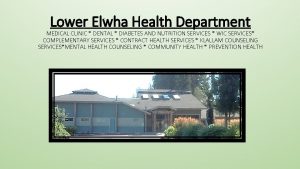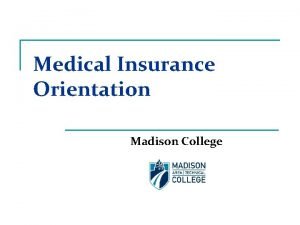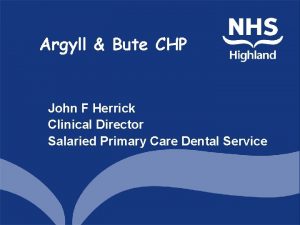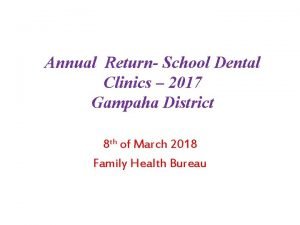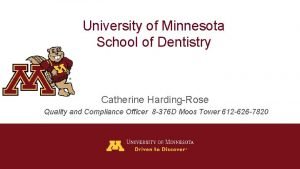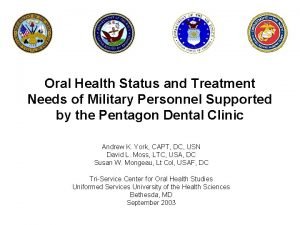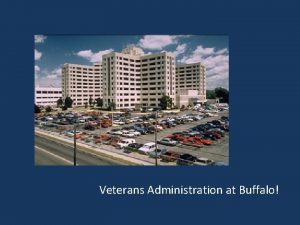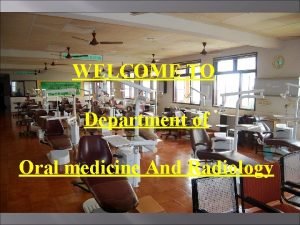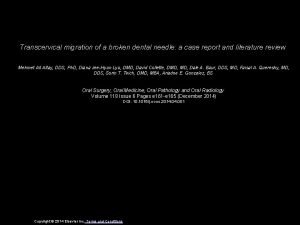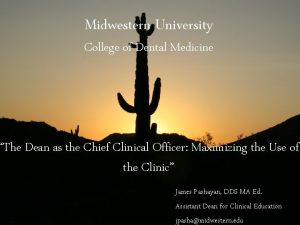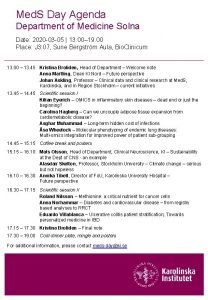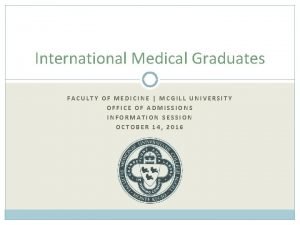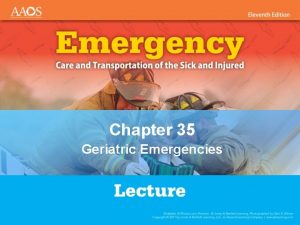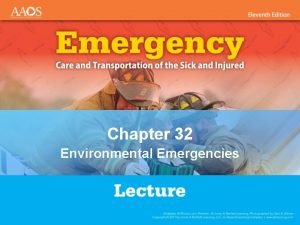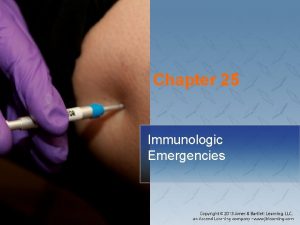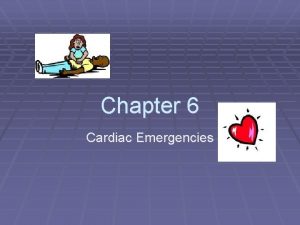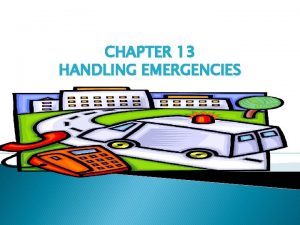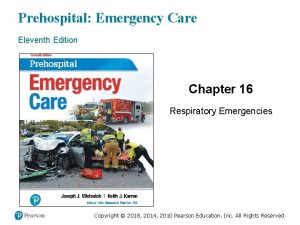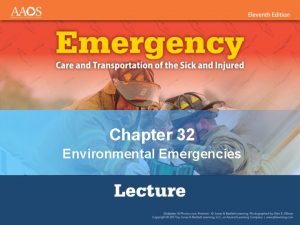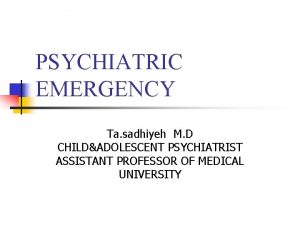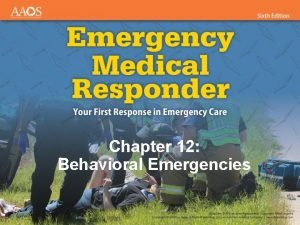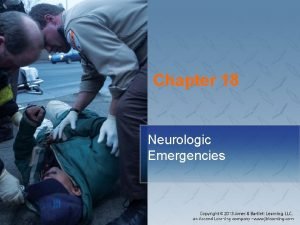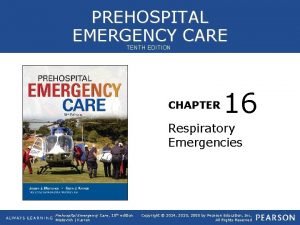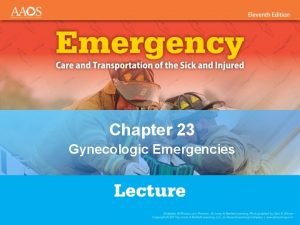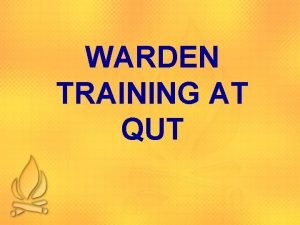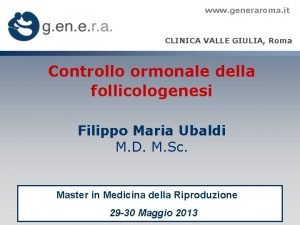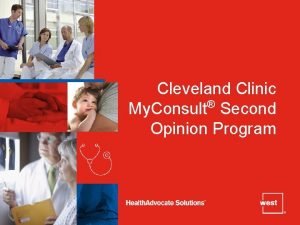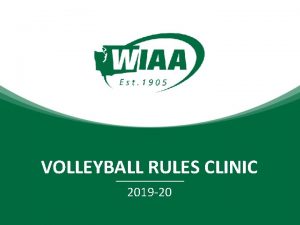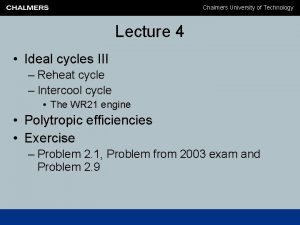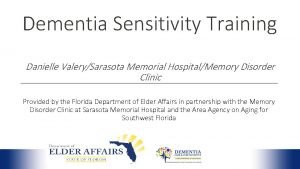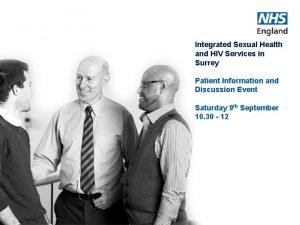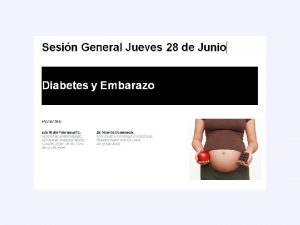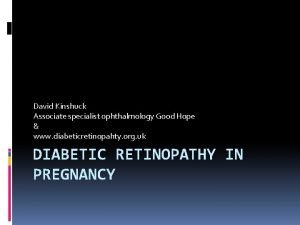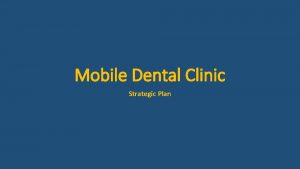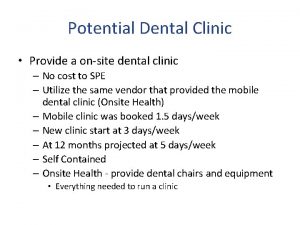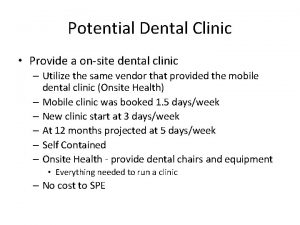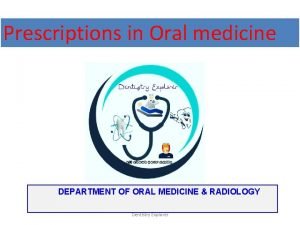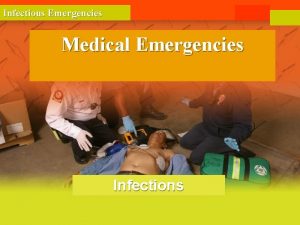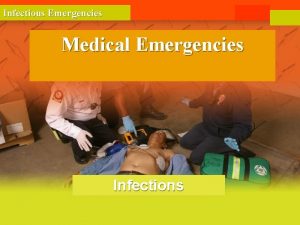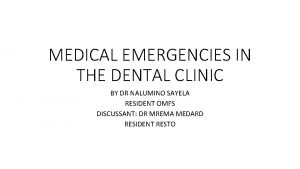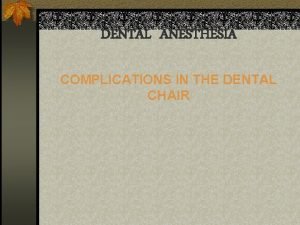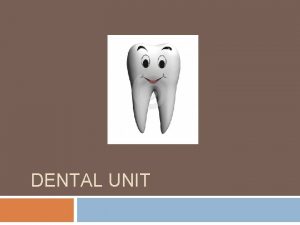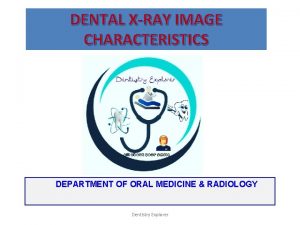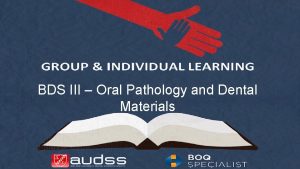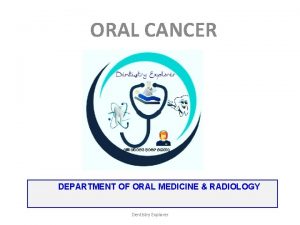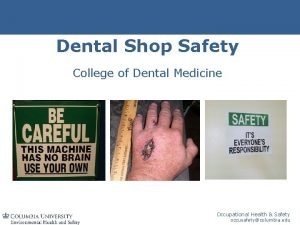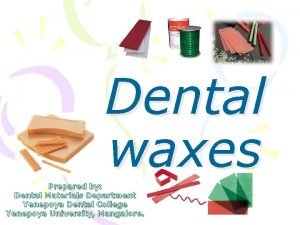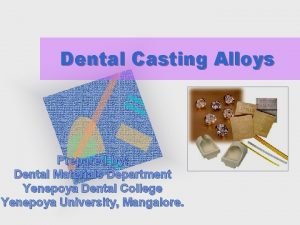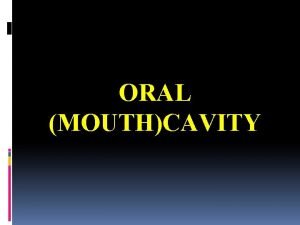EMERGENCIES IN DENTAL CLINIC DEPARTMENT OF ORAL MEDICINE












































- Slides: 44

EMERGENCIES IN DENTAL CLINIC DEPARTMENT OF ORAL MEDICINE & RADIOLOGY Dentistry Explorer

Sudden occurrence, often dangerous health related events, needs prompt diagnosis and management to save the life. Dentistry Explorer

INTRODUCTION • Emergencies can happen to anyone- a patient, a doctor, a member of staff or a person who is merely accompanying the patient. • Although, the occurrence of life threatening emergencies in dental office is infrequent, many factors that increase the likeliness of such incidents includes: – Older patients – Long dental appointments – Increased use and administration of drugs in dentistry. Dentistry Explorer

Classification of life threatening situations. Two way of classification: 1. Syatem oriented : q Infectious diseases q. Immune system • Allergies ØAngioneuritic edema ØContact dermititis ØAnaphylaxis Dentistry Explorer

skin and appendages eye ear nose throat respiratory tract asthma q Cardiovascular system atherosclerotic heart disease angina pectoris myocardial infraction. heart failure. q q Dentistry Explorer

q Blood q Gastro intestinal tract liver. q Obstetrics and gynecology q Nervous system unconsciousness syncope hyperventilation vasodepressor syncope orthostatic hypotension convulsive disorders epilepsy Dentistry Explorer

q Drug over dose reaction q Cerebrovascular accident q Endocrine disorders diabetes disorders hyperglycemia hypoglycemia thyroid gland hyperthyroidism hypothyroidism adrenal gland acute adrenal insufficiency Dentistry Explorer

2. Based on stress and cardiovascular system 1. Non cardiovascular emergencies A. Stress related - Vasodepressor syncope - hyperventilation - hypoglycemia - seizures - acute adrenal insufficiency - thyroid crisis - asthma B. Non stress related - Orthostatic hypotension - overdose reaction - hyperglycemia - allergy Dentistry Explorer

2. Cardiovascular emergencies A. Stress related - angina pectoris - acute myocardial infarction - heart failure - cerebral ischemia and infarction B. Non stress related - acute myocardial infarction Clinical signs and symptoms 1. unconsciousness 2. respiratory distress 3. altered consciousness 4. seizures disorder 5. drug related emergency situation 6. chest pain 7. cardiac arrest Dentistry Explorer

How can medical emergencies be prevented? • Physical examination - Medical history - physical examination - dialogue history • Psychological examination - medical history - anxiety questionnaire - observation increased blood pressure and heart rate trembling excessive sweating dilated pupils Dentistry Explorer

Goals of physical and psychological examination To determine • The patient’s ability to physically tolerate the stress involved in planned treatment. • The patient ability to psychologically tolerate the stress involved in planned treatment. • Treatment modification needed or not to tolerate stress • Whether psycho sedation needed or not. • Sedation technique is appropriate • Medications are contraindicated or not Dentistry Explorer

Preparation is the second most important factor in the management of emergencies. it includes: – P: position of patient – A: airway--can be obtained and maintained by – Head tilt – chin lift technique – Jaw thrust technique – B: breathing-- can be provided by » Mouth to mouth / mouth to mask ventillation » Resuscitation bag ventillation – C: circulation--provided by external cardiac compression (recommened ratio= 0: 2 3 Dentistry Explorer

– Having the auxiliary staff trained to assist in medical emergencies – Establishment and periodic testing of system to readily assess medical assistance when emergency occurs Dentistry Explorer

– Equipping office with supplies necessary for emergency care i. e. emergency drugs and euipments • ADA suggests that following drugs should be included as minimum in emergency dental kit…… – Epinephrine 1: 1000(injectable) – Histamine blocker (injectable) – oxygen with positive pressure administration capability – Nitroglycerin (sublingual tablet or aerosol spray) – Brochodialtor (astham inhaler) – Sugar – Aspirin Other drugs may be included as doctors training. Dentistry Explorer

• Above guidelines are designed to aim in development of useful dental office emergency kit. However the doctor should include only those items in the dental kit to which they are familiar and able to use. Dentistry Explorer

• The emergency drugs and equipments described in the following section are presented in 4 levels or modules on that basis of doctors training and experience in emergency medicine: – Module 1: basic emergency kit(critical drugs and equipment) – Module 2 : non critical drugs and equpiment – Module 3: advanced cardiac life support drugs – Module 4 : antidotal drugs Dentistry Explorer

Module 1 Category Generic drug Proprietary drug alternative Quantity Allergy-anaphylaxis epinephrine adrenalin none 1 preloaded syringe + 3 x 1 ml ampules Allergy-histamine blocker chlorpheniramine Chlor-trimeton diphenyhydramine 3 x 1 ml ampules Anti hypoglycemic sugar Orange juice non diet softdrink Insta glucose gel 1 bottle Platlet aggretion inhibitor aspirin many none 2 packet Injectable Non injectable Oxygen Vasodilator Bronchodilator Dentistry Explorer

equipments recommended alternative Quantity Oxygen delivery system Positive pressure &demand valves O 2 delivery system with bag valve mask device 1 large adult, 1 child Automated electronic defibrilator Many 1 AED Syringe for drug administration Plastic disposable syringe 3 x 2 ml syringe with needle for parenteral drug administration Suction & suction tip High volume, large diameter, round ended suction tips Nonelectrical suction system Office suction system Tourniquets Rubber or velcro tourniquet sphygmomanometer 3 tourniquet and 1 sphygmomanometer Magill intubation forceps Dentistry Explorer 1 pediatric Magill intubation forceps

Module 2 category Generic drug alternative quantity Anticonvulsant midazolam Diazepam 1 x 5 ml ampules Analgesic Morphine sulphate Meperidine 3 x 1 ml ampules Vasopressor phenylephrine -- 3 x 1 ml ampules Antihypoglycemic 50% dextrose Glucagon 1 vial Corticosteroid Hydrocortisone sodium succinate Dexamethasone 2 x 2 ml mix o vial Antihypertensive esmolol propanolol 2 x 100 mg/ml vial Anticholinergic atropine scopolamine 3 x 1 ml ampules Respiratory stimulant Aromatic ammonia -- 2 boxes antihypertensive nifedipine -- 1 bottle Injectable Non injectable Dentistry Explorer

Secondary emergency equipments included here are • Scalpel or cricothyrotomy needle • Artificial airways • Laryngoscopes and endotracheal tubes • Laryngeal mask airway Dentistry Explorer

Module 3: advanced life support Category Generic drug alternative Quantity Cardiac arrest epinephrine -- 3 x 1 ml preloaded syringe Analgesic Morphine sulphate N 2 O – O 2 3 x 1 ml ampule Antidysrhyhmic Lidocaine procainamide 1 preloaded syringe & 2 x 5 ml ampules Sympto. Bradycardia Atropine isoproterenol 2 x 10 ml syringe Paroxymal supra venticular tachycardia Verapamil -- 2 x 4 ml ampules Injectable noninjectable oxygen Oxygen 1 E cylinder Dentistry Explorer

Module 4: antidotal drugs Category Generic drug Alternative Quantity Opioid antagonist Naloxane Nalbuphine 2 x 1 ml ampules Benzodiazepine antagonist Flumazenil -- 1 x 10 ml vials Anticholinergic toxicity physostigmine -- 3 x 2 ml ampules Injectable Antiemergence delirium Dentistry Explorer

Most common emergency situation according to survey of dental practisioners, J Am Dent Assoc 124: 40 -53, 1993 includes the following: – – – – – Syncope (most common) Mild allergic reaction Angina pectoris Postural hypotension Seizures Asthmatic attack Hyperventilation Epinephrine reaction Hypoglycemia Cardiac arrest Anaphylactic reaction Myocardial infarction Local anesthetic overdose Heart failure Diabetic coma Cerebrovascular accident Adrenal insufficiency Thyroid storm (least common) Dentistry Explorer

Unconsciousness • Lack of response to sensory stimulus • Cause of unconsciousness in dental office include vasodepressor syncope, orthostatic hypotension, hypoglycemia, acute adrenal insufficiency, drug administration • Predisposing factor 1. stress 2. impaired physical status 3. administration of drugs - LA Dentistry Explorer

Pathophysiology 1. Reduced cerebral metabolism resulting from inadequate delivery of blood or oxygen to brain. - dilatation of peripheral arterioles - failure of normal peripheral vasoconstrictor activity - sharp fall in cardiac output - constriction of cerebral vessel as CO 2 is lost as through hyperventilation - occlusion of internal carotid artery - ventricular asystole 2. Reduced cerebral metabolism resulting from general or local metabolic deficiencies 3. Direct or reflex effects on the part of nervous system concerned with regulation of consciousness and equilibrium. 4. Psychic mechanisms affecting level of consciousness Dentistry Explorer

Management – Basic life support 1. Recognition of unconsciousnes a. Assessment of consciousness - lack of response to sensory stimulation - the loss of protective reflexes - an inability to maintain a patent airway b. Call for help 2. Position patient - Place in supine position with brain at level of heart and feet elevated slightly (100 -150 ) - Tredelenburg position should be avoided. - Pregnant woman should turned to right lateral position Dentistry Explorer

3. Assess and open airway - head tilt - Jaw thrust - Head tilt and chin lift - Head tilt and neck lift 4. Assess airway patency and breathing - look listen and feel - Remove foreign body from airway 5. Artificial ventilation Exhaled ventilation - Mouth to mouth - Mouth to nose Atmospheric air ventilation Artificial airways 6. Assess circulation 7. Definitive management Dentistry Explorer

Syncope • Syncope : - sudden, transient loss of consciousness without prodromal symptoms that is followed within seconds to minutes (<30 minutes) by resumption of consciousness, usually with premorbid status intact. Dentistry Explorer

Pathophysiology Anxiety Increased catecholamine release Decreased peripheral vascular resistance Pooling of blood in periphery Decreased arterial blood pressure Increased heart rate—feeling of warmth, pallor, perspiration, rapid breathing caused by compensatory mechanism Decompensation Reflex vagally mediated bradycardia—nausea, weakness, hypotensiion Reduced cerebral blood flow Light headedness Syncope In prolonged seizure activity Dentistry Explorer

Management • Prodrome – Terminate all dental treatment – Position patient in supine posture with legs raised above level of head – Attempt to calm patient – Place cool towel on patients forehead – Monitor vital signs Dentistry Explorer

• Syncopal episode – Terminate all dental treatment – Position patient in supine posture with legs raised above level of head – Check for breathing If absent: If present: Start basic life support Crush ammonia ampule under nose Summon medical assistance Administer oxygen Consider other causes of syncope including hypoglycemia, cv accident or cardiac dysarrythmia Monitor vital signs Have patient escorted home Dentistry Explorer

Postural hypotension • Also known as orthostatic hypotension. • It is defined as a disorder of the autonomic nervous system in which syncope occurs when the patient assumes an upright position. • It may also be defined as drop in systolic pressure of 30 mm of hg or greater or 10 mm hg or greater fall in diastolic pressure that occurs on standing Dentistry Explorer

• The most frequent cause of postural hypotension in dental office is response to use of drugs. (Drugs used to mange fear and anxiety ) • Other causes includes: – – – – Prolong period of recumbence Inadequate postural reflex Late stage pregnancy Advanced age Venous defect in legs Addison's disease Physical exhaustion or starvation Chronic paroxysmal hypotension Dentistry Explorer

Clinical manifestation • Pt with chronic postural hypotension can experience drop in blood pressure and loose consciousness whenever they stand or sit upright • Frequently, they do not exhibit any of the prodromal signs and symptom of vasodepressor syncope Dentistry Explorer

Management Assess consciousness (lack of response to sensory stimulation) Activate office emergency system P—position patient supine with legs slightly raised A-B-C—assess and open airway ; assess airway patency and breathibg Assess circulation D—Definative care: Administer o 2, monitor vital signs If pt recovers consciousness, slowly reposition the chair If delayed recovery Activate emergency medical system Continue BLS as needed Discharge the pateint Dentistry Explorer

Acute Adrenal Insufficiency • Adrenal deficiency may be primary or secondary. • Secondary form is produced by administration of exogenous glucocorticosteroids result in disuse atrophy of adrenal gland which leads to adrenal crisis during stressful condition. Predisposing factor - sudden withdrawal of steroid hormone in pt. with primary deficiency or sec. insufficiency - stress - bilateral adrenalectomy - sudden destruction of pituitary - injury to both gland by trauma Dentistry Explorer

Criteria for determining Adrenal Insufficiency • History of current or recent long-term steroid use. • Mental confusion • Nausea and vomiting • Abdominal pain • Hypotension Dentistry Explorer

Management of Acute Adrenal Insufficiency • Consciousness patient Terminate dental care Position patient in supine with feet elevated Monitor vital signs Summon medical assistance Administer glucocorticosteroid if available, and h/o acute adrenal insufficiency Additional mx. Oxygen, corticosteroid Dentistry Explorer

Unconsciousness patient Recognize unconsciousness Position patient in supine with elevated feet Provide basic life support Provide definitive mx. Obtain emergency kit and oxygen, administer corticosteriod establish IV line, Transfer hospital Dentistry Explorer

MCQ 1. Which of the following is stress related non cardiovascular emergency condition? A. Thyroid crisis Anginatopectoris 2. B. According survey of dental practisioners, J Am Dent Assoc is the most common emergency C. 124: 40 -53, 1993 Orthostatic which hypotension condition? Allergy A. D. Thyroid storm B. Syncope C. Adrenal insufficiency D. Postural hypotension Dentistry Explorer

3. ADA suggests that all of the following drugs should be included as minimum in emergency dental kit EXCEPT A. Epinephrine 1: 1000(injectable) B. Histamine blocker (injectable) C. oxygen with positive pressure administration capability D. Nitroglycerin (sublingual tablet or aerosol spray) E. All F. None (all should be included) Dentistry Explorer

4. Which of the following is NOT the predisposing factor for acute adrenal insufficiency? A. sudden withdrawal of non-steroidal antiinflammatory drugs B. Stress C. injury to both gland by trauma D. bilateral adrenalectomy Dentistry Explorer

5. Clinical signs and symptoms of emergency condition includes A. Unconsciousness B. Respiratory distress C. Seizures disorder D. Chest pain E. Cardiac arrest F. all Dentistry Explorer

Thank you Dentistry Explorer
 Emory anticoagulation clinic
Emory anticoagulation clinic Lower elwha health clinic
Lower elwha health clinic Madison college dental clinic
Madison college dental clinic Oban dental clinic
Oban dental clinic Mirigama dental clinic
Mirigama dental clinic Umn faculty dental clinic
Umn faculty dental clinic Factors affecting child behaviour in dental clinic
Factors affecting child behaviour in dental clinic Pentagon dental clinic
Pentagon dental clinic Buffalo dental clinic
Buffalo dental clinic Oral disease
Oral disease Oral medicine
Oral medicine Midwestern university college of dental medicine
Midwestern university college of dental medicine Department of medicine solna
Department of medicine solna Faculty of medicine mcgill
Faculty of medicine mcgill Emt chapter 18 gastrointestinal and urologic emergencies
Emt chapter 18 gastrointestinal and urologic emergencies Major nutritional deficiency diseases in emergencies
Major nutritional deficiency diseases in emergencies Gems diamond geriatric assessment
Gems diamond geriatric assessment Chapter 32 environmental emergencies
Chapter 32 environmental emergencies During a psychiatric emergency the emt should be able to
During a psychiatric emergency the emt should be able to Immunologic emergencies
Immunologic emergencies Chapter 28 lesson 1
Chapter 28 lesson 1 Lesson 6: cardiac emergencies and using an aed
Lesson 6: cardiac emergencies and using an aed Chapter 17 cardiovascular emergencies
Chapter 17 cardiovascular emergencies Chapter 13 handling emergencies
Chapter 13 handling emergencies Chapter 19 endocrine and hematologic emergencies
Chapter 19 endocrine and hematologic emergencies A 41 year old man presents with slow irregular breathing
A 41 year old man presents with slow irregular breathing Chapter 16 respiratory emergencies
Chapter 16 respiratory emergencies Environmental emergencies emt
Environmental emergencies emt Psychiatric emergencies
Psychiatric emergencies Chapter 12 behavioral emergencies
Chapter 12 behavioral emergencies Chapter 18 neurologic emergencies
Chapter 18 neurologic emergencies Chapter 16 respiratory emergencies
Chapter 16 respiratory emergencies Besides being required for diver training
Besides being required for diver training Oncological emergencies wikipedia
Oncological emergencies wikipedia Chapter 23 gynecologic emergencies
Chapter 23 gynecologic emergencies Qut security emergency extension number
Qut security emergency extension number Valle giulia clinica
Valle giulia clinica Cleveland clinic second opinion
Cleveland clinic second opinion Port gamble health clinic
Port gamble health clinic Wiaa libero tracking sheet
Wiaa libero tracking sheet Erik sintorn
Erik sintorn Tmh memory disorder clinic
Tmh memory disorder clinic Gum clinics surrey
Gum clinics surrey Incremento ponderal
Incremento ponderal Good hope eye clinic
Good hope eye clinic

